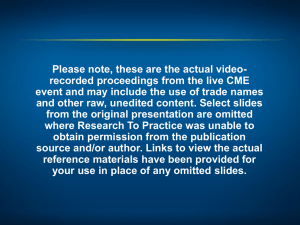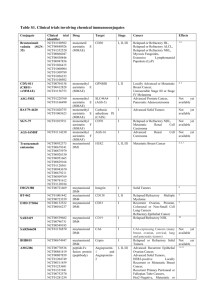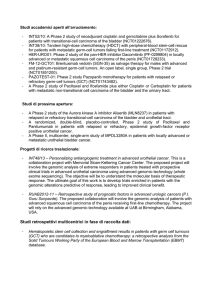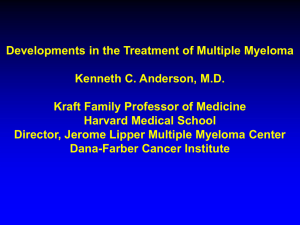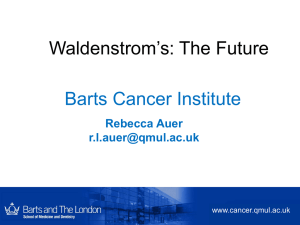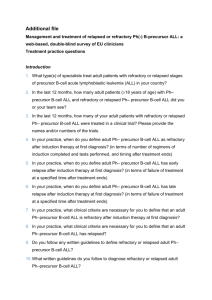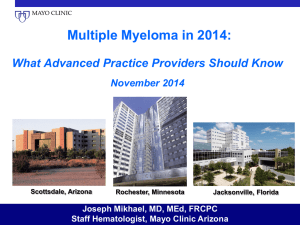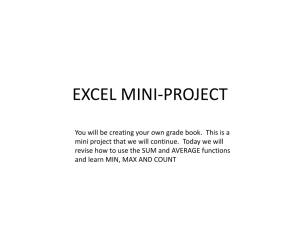MLN9708 in Relapsed and/or Refractory MM
advertisement
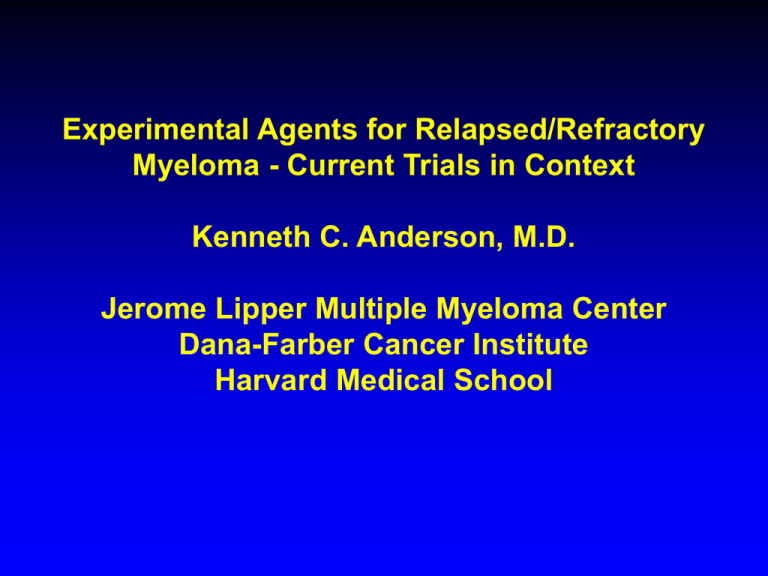
Experimental Agents for Relapsed/Refractory Myeloma - Current Trials in Context Kenneth C. Anderson, M.D. Jerome Lipper Multiple Myeloma Center Dana-Farber Cancer Institute Harvard Medical School Conflict of Interest: Kenneth C. Anderson, M.D. Consultancy: Celgene, Onyx, Sanofi Aventis, and Gilead Scientific Founder: Acetylon, Oncopep Integration of Novel Therapy Into Myeloma Management Bortezomib, Lenalidomide, Thalidomide, Pegylated Liposomal Doxorubicin, Carfilzomib, Pomalidamide Target MM in the BM microenvironment to overcome conventional drug resistance in vitro and in vivo Effective in relapsed/refractory, relapsed, induction, consolidation, and maintenance therapy Eight FDA approvals and median survival prolonged from 3-4 to 6-7 years, with additional prolongation from maintenance New approaches needed to treat and ultimately prevent relapse Targeting Growth, Survival, and Drug Resistance of MM MM in BM Microenvironment migration CD40 Cell surface targets BAFF-R GSK-3 FKHR PKC Survival Caspase-9 Anti-apoptosis Akt NF-B Cell cycle mTOR PI3-K Bad Survival Bcl-xL JAK/STAT3 Anti-apoptosis Mcl-1 Raf VEGFR NF-B Cytokines IL-6, VEGF IGF-1, SDF-1 BAFF, APRIL BSF-3 TNF TGF VEGF MEK/ERK Bcl-xL IAP Cyclin-D MEK/ERK p27Kip1 proliferation Survival Anti-apoptosis Cell cycle Proliferation Anti-apoptosis Smad, ERK cytokines BMSC Adhesion NF-B NF-B NF-B Hideshima T and Anderson KC. Nat Rev Cancer 2007, adhesion molecules LFA-1 ICAM-1 VCAM-1 Fibronectin MUC-1 VLA-4 SC Overview of Phase III Trials with Len and Bortezomib in Relapsed/Refractory MM ORR, CR or ≥ VGPR, % nCR, % % Regimen Trial Len + dex MM-009[1] Len + dex [2] 61 24 NE DOR, Mos 16 TTP or PFS, Mos 11 Median OS, Mos 35[5] MM-010 60 25 NE 17 11 Bortezomib APEX[3] 43 16 NE 8 6 30 Vdox MMY3001[4] 44 13 27 10 9 NE 1. Weber DM, et al. N Engl J Med. 2007;357:2133-2142. 2. Dimopoulos M, et al. N Engl J Med. 2007;357:2123-2132. 3. Richardson PG, et al. Blood. 2007;110:3557-3560. 4. Orlowski RZ, et al. J Clin Oncol. 2007;25:3892-3901. 5. Weber D, et al. Blood. 2007;110:Abstract 412. Efficacy and Toxicity by Bortezomib schedule VMP* (VISTA) VMP twice weekly N=63 VMP once weekly N=190 CR 30% 27% 23% PFS @ 3 years NA 32% 35% Any grade 44% 43% 21% Grade 3-4 13% 14% 2% PN discontinuation NA 16% 4% Total planned dose 67.6 67.6 mg/m2 46.8 mg/m2 Total delivered dose NA 41 mg/m2 40 mg/m2 Sensory PN *Mateos et al. J Clin Oncol 2010; PN: peripheral neuropathy Palumbo et al. ASH 2010 abstr 620 SC vs. IV Bortezomib for Relapsed/Refractory Myeloma Moreau et al. ASH 2010 abstr 312 EQUIVALENT EFFICACY Bortezomib IV (N=74) Bortezomib SC (N=148) Pvalue* Any PN event, % 53 38 0.04 Grade 2, % 41 24 0.01 Grade 3, % 16 6 0.03 Grade 1 PN at baseline 28 23 Diabetes at baseline 11 13 Exposure to prior neurotoxic agents 85 86 Peripheral Neuropathy Risk factors for PN, % *P-values are based on 2-sided Fisher’s exact test When to Consider Retreatment • Differences between biochemical relapse and symptomatic relapse need to be considered • Patients with asymptomatic rise in M-protein can be observed to determine the rate of rise and nature of the relapse – Caveat: patients with known aggressive or high-risk disease should be considered for salvage even in the setting of biochemical relapse • CRAB criteria are still listed as the indication to treat in the relapsed setting – C: Calcium elevation (> 11.5 mg/L or ULN) R: Renal dysfunction (serum creatinine > 2 mg/dL) A: Anemia (Hb < 10 g/dL or 2 g < normal) B: Bone disease (lytic lesions or osteoporosis) Considerations in Patients With Relapsed/Refractory Myeloma • Previous therapy • Response to previous therapy • Patient characteristics and other prognostic factors – Older than 65 yrs of age – Increased β2-M, decreased serum albumin, low platelet count – Cytogenetic abnormalities: del(13q), t(4;14) – Renal dysfunction • Up to 50% of patients with MM have renal dysfunction • Between 20% and 30% of patients have concomitant renal failure – Extensive bone disease; extramedullary MM Kyle RA, et al. Mayo Clin Proc. 2003;78:21-33. Kumar SK, et al. Mayo Clin Proc. 2004;79:867-874. Facon T, et al. Blood. 2001;97:1566-1571. Barlogie B, et al. Blood. 2004;103:20-32. Fonseca R, et al. Cancer Res. 2004;64:1546-1558. Kyle RA. Stem Cells. 1995;13(suppl 2):56-63. Bladé J, et al. Arch Intern Med. 1998;158:1889-1893. Current and Future Directions 1. Development of immune therapies 2. Development of new oral proteasome inhibitors 3. Development of rationally based combination therapies 4. Identification of novel targets MAb-Based Therapeutic Targeting of Myeloma Antibody-dependent Cellular cytotoxicity (ADCC) Complement-dependent Cytotoxicity (CDC) Apoptosis/growth arrest via targeting signaling pathways C1q C1q Effector cells: CDC MM MM ADCC FcR Daratumumab (CD38) MM Lucatumumab or Dacetuzumab (CD40) Elotuzumab (CS1) Daratumumab (CD38) XmAb5592 (HM1.24) huN901-DM1 (CD56) nBT062-maytansinoid (CD138) 1339 (IL-6) BHQ880 (DKK1) RAP-011 (activin A) Daratumumab (CD38) Tai & Anderson Bone Marrow Research 2011 Phase II: Elotuzumab + Len + Low-Dose Dex in Rel/Ref MM (Study 1703) Phase 1* N=28 Phase 2 N=73 R A N D O M I Z E Elotuzumab 10 mg/kg IV + Len/dex n=36 Elotuzumab 20 mg/kg IV + Len/dex n=37 P R O G R E S S I O N† • Phase 2: Pts (n=73) with relapsed and/or refractory MM with 1-3 prior therapies were randomized to elotuzumab 10 or 20 mg/kg IV combined with – – Lenalidomide 25 mg PO Low-dose dexamethasone 40 mg PO • Endpoints – – Primary: ORR (≥PR per IMWG Criteria) Key secondary endpoints: PFS and safety Len/dex: lenalidomide plus low dose dexamethasone †Progression defined by IMWG Criteria. *Lonial et al. J Clin Oncol. 2012 Richardson et al. ASH 2012 Efficacy: Maximum Percent Reduction in Serum M Protein* 60 10 mg/kg Elotuzumab (n=36) 50 50 40 40 30 30 20 10 0 -10 -20 -30 -40 -50 -60 -70 Percentage Change from Baseline Percentage Change from Baseline 60 20 mg/kg Elotuzumab (n=29)† 20 10 0 -10 -20 -30 -40 -50 -60 -70 -80 -80 -90 -90 -100 -100 *Maximum percentage decrease from baseline to 60 d after permanent discontinuation of elotuzumab or start of new line of MM therapy. †Eight pts without measurable disease (baseline and all on-study serum M-protein levels <0.5 g/dL) were not included. Richardson et al. ASH 2012 ASH 2012: Progression Free Survival Proportion of Progression Free Patients (%) 100 90 80 70 60 10 mg/kg 50 40 20 mg/kg 30 Median Time to Progression/Death: 20 10 mg/kg (n=36): not yet reached 10 20 mg/kg (n=37): 18.6 mos (95% CI 12.9-29.7) 0 0 Number at Risk: 36 37 3 6 9 12 15 18 21 24 27 30 33 18 15 18 13 13 13 9 10 3 3 0 0 Mos 32 29 30 26 29 23 23 21 20 17 At a median follow-up of 20.8 mos, median PFS has not been reached in the 10 mg/kg arm – Preliminary median PFS of 26.9 mos was reported in the abstract; after 2.7 mos of additional follow-up, no new PD or death reported. These pts had an increased PFS duration, and in the updated analysis, median PFS was not yet reached Richardson et al. ASH 2012 Phase 2 Elotuzumab + Lenalidomide LowDose Dex in Relapsed/Refractory MM • Elotuzumab plus lenalidomide and low-dose dexamethasone has a high ORR in relapsed and relapsed/refractory MM – 82% for all pts (91% in pts who had received only 1 prior therapy) – 92% for pts treated with elotuzumab 10 mg/kg Median PFS was 33 mos for patients receiving elotuzumab 10 mg/kg • The combination was generally well tolerated – Most common Grade 3/4 treatment-emergent AEs were neutropenia (16%), thrombocytopenia (16%), and lymphopenia (16%) – Premedication regimen decreased incidence and mitigated severity of infusion reactions* Richardson et al. ASH 2012, Lonial et al. ASCO 2013 Daratumumab A human CD38 mAb with broad-spectrum killing activity 18 of 29 patients in phase I benefit (5PR,4MR,9SD) Lokhorst et al. EHA 2012 Daratumumab Response Maximal Change in Paraprotein A: serum M-component 9 B: urine M-component C: FLC 2 100 Reletive change in paraproteine from baseline (% ) < 1 mg/kg 50 2 mg/kg 4 mg/kg 8 mg/kg 16 mg/kg 24 mg/kg 5 1 20 19 10 12 31 16 29 0 8 A A B A C A A A A A A B A B A A C A C 13 C C A A A A A A B C A A C 4 26 15 3 7 11 17 14 33 27 -50 21 6 30 18 34 23 32 -100 22 28 Patient number Phase I/Ii Study of Daratumumab Cd38 Monoclonal Antibody in Relapsed/Refractory Mm • Favorable safety profile as monotherapy • In 15 of 32 (47%) showed benefit – 4 patients achieving PR (13%) – 6 patients achieving MR (19%) – 5 patients achieving SD (16%) • At doses 4mg/kg and above, 8 of the 12 patients had at least MR (66%) • To be combined with lenalidomide & dexamethasone Plesner et al. ASH 2012 Abstr 73 Phase I Trial of Vaccination with DC/MM Fusions in Relapsed Refractory MM • Well tolerated, no autoimmunity • Induced tumor reactive lymphocytes in a majority of patients • Induced humoral responses to novel antigens (SEREX analysis) • • DC/MM fusions induce anti• Disease stabilization in 70% MM immunity in vitro and of patients inhibit MM cell growth in vivo in xenograft models Vasir et al. Brit J Hematol 2005; 129: 687-700 Rosenblatt et al. Blood 2011; 117:393-402. Proteasome: Present and Future Therapies Potential Therapeutic Targets UB enzymes E1, E2 and E3-UB-Ligases Deubiquitylating Enzymes (DUBs)) Ub Ub ATPases/ Cdc48 Ub P5091 target USP-7 ATP Poly-ubiquitinated proteins (proteasome substrates) Immunoproteasome ADP PR-924 19S Six Protease activities 20S 20S 5, 5i 1, 1i 2, 2i 19S Free 5 NPI-0052: 5, 1, 2 Ub for re-cycling Bortezomib, Carfilzomib, CEP-18770 ONX-0912 MLN 2238 Degraded protein 26S PROTEASOME MLN2238/9708 Decreases Cell Viability in MM Cells and Overcomes Bortezomib Resistance 24h 48h Chauhan et al. Clin Cancer Res, 2011; 17: 5311-21. MLN9708 (Ixazomib) in Relapsed/Refractory MM Oral single-agent MLN9708 administered on days 1, 8, and 15 of a 28-day cycle, for up to 12 cycles* Doseescalation cohorts Dose-escalation: 3+3 schema, based on cycle 1 DLTs (modified Fibonacci dose sequence) 0.24→0.48→0.8→1.2→1.68→2.23→2.97→3.95 mg/m2 MTD established Expansion cohorts Relapsed and refractory Bortezomibrelapsed Proteasome inhibitor-naïve Prior carfilzomib Refractory to most recent therapy (PD while on or within 60 days of last therapy) Relapsed after previous bortezomib therapy but not refractory Relapsed after ≥1 therapy including an IMiD compound, no proteasome inhibitor Received prior carfilzomib and with relapsed or refractory disease Kumar et al. ASCO 2013 Weekly MLN9708 in Relapsed/Refractory Multiple Myeloma: Phase I Study • Single-agent oral MLN9708 MTD 2.97 mg/m2 on a weekly (days 1, 8, and 15 every 28 days) schedule • Oral MLN9708 generally well tolerated – hematologic and gastrointestinal events generally manageable, low rate of discontinuations – Infrequent PN, only 1 grade 3 PN • Pharmacokinetic profile supports weekly oral dosing • Relapsed and/or refractory MM patients (median 4 prior lines of therapy) – ORR (≥PR) of 18%, plus 2% MR and 30% SD, including relapse post Bortezomib Kumar et al. ASCO 2013 MLN9708 in Relapsed and/or Refractory MM: Expansion Cohorts of a Phase 1 Dose-Escalation Study Richardson et al. ASH 2011 • 46 pts evaluable for response – 21 in dose-escalation cohorts – 30 in expansion cohorts (including 6 from dose-escalation cohorts) • 6 pts have achieved ≥PR – 1 CR, confirmed by bone marrow (PI-naïve expansion cohort) – 5 PRs (1 each at 1.2 and 2.23 mg/m2 in dose-escalation cohorts; 1 in RRMM and 2 in bortezomib-relapsed expansion cohorts) • 1 pt achieved MR (bortezomib-relapsed expansion cohort; 40% M-protein reduction) • All 7 pts remain in response, with duration of disease control of up to 15.9 months • 28 pts have achieved SD – 14 in dose-escalation cohorts – 9, 5, and 2 in RRMM, bortezomib-relapsed, and PI-naïve expansion cohorts – Durable, with disease stabilization for up to 12.9 months Phase 1/2 Study of MLN9708 Lenalidomide and Dex in Patients with Previously Untreated MM • Oral weekly MLN9708, lenalidomide, and dexamethasone is well tolerated – incidence of PN has been limited At median drug exposure of 6 months, 92% PR or better, including ≥VGPR 55% and CR 23% – Responses increased with number of cycles and deepened over time – 88% of patients achieving CR who were evaluable for MRD status were confirmed as MRD-negative • A phase 3 trial of MLN9708 plus lenalidomide–dexamethasone versus placebo plus lenalidomide–dexamethasone in patients with relapsed and/or refractory MM is currently enrolling (NCT01564537) for new drug approval Kumar et al. ASH 2012 Abstr 332 In Vitro Anti-MM Activity of Oral Chymotryptic Inhibitor ONX 0912 (Oprozomib) Myeloma Cell Lines Patient Tumor Cells • Phase I clinical trials ongoing Chauhan et al. Blood. 2010;116:490614. Marizomib: A Non-Peptide Proteasome Inhibitor Induces Rapid, Broad and Prolonged Inhibition Marizomib (NPI-0052) H H H N O OH O O H CH3 Cl • Exhibits high levels of proteasome inhibition without toxicities associated with bortezomib • Active in bortezomib and immunomodulatorresistant myeloma preclinically Chauhan et al. Cancer Cell 2005; 8: 407-19. Responses to Marizomib +/- Dexamethasone in Evaluable Pts at Full Dose [ >0.4 mg/m2 ]* Twice Weekly (n=21**) Richardson et al. ASH 2011 Pts Refractory to Bortezomib All Pts EBMT ≥ SD MR + PR Uniform Criteria ≥ SD PR + VGPR 11/20 3/20 12/21 4/21 55% 15% EBMT ≥ SD MR + PR 8/12 2/12 67% 17% 57% 19% Uniform Criteria ≥ SD PR + VGPR 8/12 2/12 67% 17% Median Duration of Response (all Pts) = 133 days (~ 5 mos) Pts Exposed to Bortezomib EBMT ≥ SD MR + PR Uniform Criteria ≥ SD PR + VGPR 11/19 3/19 11/19 3/19 Pts Refractory to Lenalidomide 58% 16% EBMT ≥ SD MR + PR 8/13 3/13 62% 23% 58% 16% Uniform Criteria ≥ SD PR + VGPR 9/14 4/14 64% 29% • Response criteria defined with baseline SPEP ≥ 0.5 g/dL or UPEP ≥ 200 mg/24h with at least 2 assessments after treatment Day 1 for EBMT ; also by free lite for UC**. *As of 05 Dec 11 • Refractory defined as having PD during or within 60 days of last regimen. Additional Targeted Therapies in Development • • • • • • KSP inhibitors (ARRY-520) AKT inhibitor (GSK2110183) Nuclear transport inhibitors (KPT) CDK inhibitors BTK inhibitors Bromodomain inhibitors Development of Rationally based Combination Therapies (HDAC and Proteasome Inhibitors) Protein Ub Ub Ub protein aggregates (toxic) Ub Ub 26S proteasome Ub HDAC6 Ub Panobinostat, Vorinostat, ACY1215 Ub Bortezomib, Carfilzomib, NPI0052, MLN9708, ONX 0912 HDAC6 dynein Ub HDAC6 dynein Microtubule Ub Aggresome Ub Ub Lysosome Ub Ub Ub Ub Autophagy Hideshima et al. Clin Cancer Res. 2005;11:8530.Catley et al. Blood. 2006;108:3441-9. VANTAGE 088: An International, Multicenter, Randomized, Double-Blind Study of Vorinostat or Placebo with Bortezomib in Relapsed MM • The combination of vorinostat + bortezomib is active in patients with relapsed and refractory MM – Significant improvement in response rate – ORR 54% vs. 41% (P<0.0001); CBR 71% vs 53% (P<0.0001) • PFS and TTP were prolonged in the combination arm compared with bortezomib alone PFS hazard ratio reduction of 23% (P=0.01); 7.63 months (6.9–8.4) versus 6.83 months (5.7–7.7) • Diarrhea, fatigue, and thrombocytopenia limited tolerability. Dimopoulos et al. ASH 2011, Lancet Oncology, in press Bench to Bedside Translation of HDAC 6 Selective Inhibitor ACY1215 Orally bioavailable, highly potent, selective inhibitor of HDAC 6 synthesized in fall 2009 Synergistic MM cytotoxicity with bortezomib in vitro and in vivo Favorable PK/PD, toxicity profile Phase Ia/Ib/II clinical trials of ACY1215, alone and with bortezomib and with lenalidomide/dexamethasone, ongoing; trials with pomalidomide and carfilzomib this year. Santo et al. Blood 2012;119:2579-89 Mutations in Myeloma 19 Patients Each With Newly Diagnosed and Relapsed MM Chapman et al. Nature 2011; 471: 467-72. • Protein homeostasis: 42% including FAM46C, RPL10, RPS6KA1, EIF3B, XBP1, LRRK2 • NF-kB signaling: 10 point mutations, 4 additional structural rearrangements affecting coding Confers bortezomib sensitivity • Histone methylating enzymes: WHSC1, UTX, MLL • BRAF: 4% activating : Single patient MM response Andrulis et al Cancer Discovery 2013; 3: 862-9. • PSMB5 b5 proteasome subunit mutation confers proteasome inhibitor resistance in laboratory, not identified in clinic Lichter et al. Blood 2012: 120: 4513-16. Current and Future Directions 1. Development of immune therapies 2. Development of new oral proteasome inhibitors 3. Development of rationally based combination therapies 4. Identification of novel targets United Nations Against Myeloma: Bench to Bedside Research Team USA UK India Italy Israel Kenneth Anderson Nikhil Munshi Paul Richardson Robert Schlossman Irene Ghobrial Steven Treon Jacob Laubach Deborah Doss Kathleen Colson Mary McKenney Kim Noonan Tina Flaherty Kathleen Finn Muriel Gannon Stacey Chuma Janet Kunsman Diane Warren Carolyn Revta Andrea Freeman Alexis Fields Andrea Kolligian John Feather Farzana Masood Nora Loughney Heather Goddard Tiffany Poon Nicole Stavitzski Ranjit Banwait Shawna Corman Heather Goddard Meghan Marie Leahy Caitlin O’Gallagher Christina Tripsas Karin Anderson Shannon Viera Katherine Redman Amber Walsh Samir Amin Wanling Xie Parantu Shah Holly Bartel Lisa Popitz Jeffrey Sorrell Japan Canada Germany Austria China Teru Hideshima Constantine Mitsiades Dharminder Chauhan Noopur Raje Yu-Tzu Tai Ruben Carrasco James Bradner Gullu Gorgun Jooeun Bae Francesca Cottini Michele Cea Antonia Cagnetta Teresa Calimeri Edie Weller Ajita Singh Ze Tian Diana Cirstea Yiguo Hu Naoya Mimura Jiro Minami Sun-Yung Kong Weihua Song Douglas McMillin Catriona Hayes Steffen Klippel Jana Jakubikova Panisinee Lawasut Niels van de Donk Eugen Dhimolea Jake Delmore Hannah Jacobs Masood Shammas Mariateresa Fulciniti Jianhong Lin Jagannath Pal Samantha Pozzi Loredana Santo Claire Fabre Anuj Mahindra Rao Prabhala Jake Delmore Puru Nanjappa Michael Sellito Avani Vaishnav Greece Taiwan Turkey Australia Ireland
